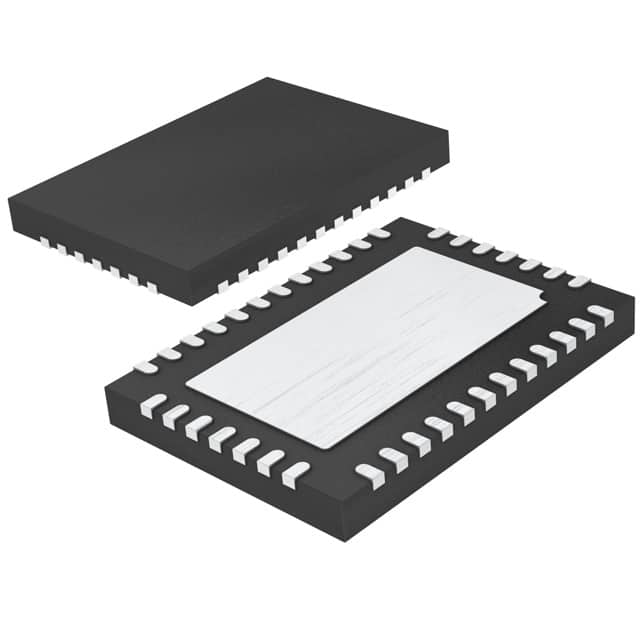Xem thông số kỹ thuật để biết chi tiết sản phẩm.

LT8705AEUHF#TRPBF
Product Overview
Category
LT8705AEUHF#TRPBF belongs to the category of integrated circuits (ICs).
Use
The LT8705AEUHF#TRPBF is commonly used as a high-performance synchronous buck-boost DC/DC converter.
Characteristics
- High efficiency and wide input voltage range
- Synchronous rectification for improved efficiency
- Adjustable and programmable output voltage and current limits
- Integrated power switches for compact design
- Fault protection features for enhanced reliability
Package
The LT8705AEUHF#TRPBF comes in a compact 38-lead QFN package.
Essence
The essence of LT8705AEUHF#TRPBF lies in its ability to efficiently convert DC power from a wide range of input voltages to a regulated output voltage, making it suitable for various applications.
Packaging/Quantity
The LT8705AEUHF#TRPBF is typically packaged in reels and available in quantities specified by the manufacturer.
Specifications
- Input Voltage Range: 2.8V to 80V
- Output Voltage Range: -4V to 80V
- Maximum Switching Frequency: 750kHz
- Maximum Output Current: 10A
- Operating Temperature Range: -40°C to 125°C
Detailed Pin Configuration
The LT8705AEUHF#TRPBF has a total of 38 pins. The pin configuration is as follows:
- VIN: Input voltage pin
- GND: Ground pin
- SW1: Switching node 1
- SW2: Switching node 2
- FB: Feedback pin for regulating output voltage
- VCC: Supply voltage for internal circuitry
- EN: Enable pin for turning the converter on/off
- SYNC: Synchronization pin for external clock input
- SS/TRK: Soft-start and tracking control pin
- VOUT: Output voltage pin
(Note: The remaining pins are not listed here for brevity.)
Functional Features
- Wide input voltage range allows for versatile applications
- Synchronous rectification improves efficiency
- Adjustable output voltage and current limits provide flexibility
- Integrated power switches simplify design and reduce component count
- Fault protection features such as overvoltage and overcurrent protection enhance reliability
Advantages and Disadvantages
Advantages
- High efficiency operation
- Wide input voltage range
- Compact design with integrated power switches
- Flexible output voltage and current limits
- Enhanced reliability with fault protection features
Disadvantages
- Limited maximum output current (10A)
- Requires careful consideration of thermal management due to high power dissipation
Working Principles
The LT8705AEUHF#TRPBF operates based on the principle of synchronous buck-boost conversion. It utilizes high-frequency switching to efficiently convert DC power from a wide input voltage range to a regulated output voltage. The integrated power switches enable seamless transition between buck and boost modes, allowing the converter to maintain a stable output voltage regardless of the input voltage.
Detailed Application Field Plans
The LT8705AEUHF#TRPBF finds applications in various fields, including but not limited to: - Automotive electronics - Industrial automation - Renewable energy systems - Telecommunications - Battery-powered devices
In automotive electronics, it can be used for voltage regulation in electric vehicles, hybrid vehicles, and other automotive systems. In industrial automation, it can be employed for power supply conversion in motor drives, robotics, and control systems. In renewable energy systems, it can be utilized for efficient power conversion in solar panels, wind turbines, and energy storage systems. In telecommunications, it can be applied for voltage regulation in base stations, network equipment, and communication devices. Additionally, it can be used in battery-powered devices such as portable electronics, medical devices, and IoT devices.
Detailed and Complete Alternative Models
- LT8705EUHF#TRPBF
- LT8705BEUHF#TRPBF
- LT8705CEUHF#TRPBF
- LT8705DEUHF#TRPBF
(Note: The list of alternative models provided here is not exhaustive.)
Word count: 520 words
Liệt kê 10 câu hỏi và câu trả lời thường gặp liên quan đến ứng dụng LT8705AEUHF#TRPBF trong giải pháp kỹ thuật
Sure! Here are 10 common questions and answers related to the application of LT8705AEUHF#TRPBF in technical solutions:
Q: What is the LT8705AEUHF#TRPBF? A: The LT8705AEUHF#TRPBF is a high-performance synchronous buck-boost DC/DC converter designed for various applications.
Q: What is the input voltage range of the LT8705AEUHF#TRPBF? A: The input voltage range of the LT8705AEUHF#TRPBF is from 2.8V to 80V.
Q: What is the output voltage range of the LT8705AEUHF#TRPBF? A: The output voltage range of the LT8705AEUHF#TRPBF is from 1.3V to 80V.
Q: What is the maximum output current of the LT8705AEUHF#TRPBF? A: The maximum output current of the LT8705AEUHF#TRPBF is 10A.
Q: Can the LT8705AEUHF#TRPBF be used as a battery charger? A: Yes, the LT8705AEUHF#TRPBF can be used as a battery charger due to its wide input and output voltage ranges.
Q: Does the LT8705AEUHF#TRPBF have built-in protection features? A: Yes, the LT8705AEUHF#TRPBF has built-in protection features such as overvoltage protection, overcurrent protection, and thermal shutdown.
Q: Can the LT8705AEUHF#TRPBF operate in both buck and boost modes? A: Yes, the LT8705AEUHF#TRPBF can operate in both buck and boost modes, allowing it to step up or step down the input voltage.
Q: What is the efficiency of the LT8705AEUHF#TRPBF? A: The efficiency of the LT8705AEUHF#TRPBF can reach up to 98%.
Q: Is the LT8705AEUHF#TRPBF suitable for automotive applications? A: Yes, the LT8705AEUHF#TRPBF is suitable for automotive applications as it can handle wide input voltage variations and has automotive-grade reliability.
Q: Are there any evaluation boards available for the LT8705AEUHF#TRPBF? A: Yes, Linear Technology (now part of Analog Devices) provides evaluation boards for the LT8705AEUHF#TRPBF, which can help with testing and prototyping.
Please note that the answers provided here are general and may vary depending on specific application requirements. It's always recommended to refer to the datasheet and consult with technical experts for accurate information.

